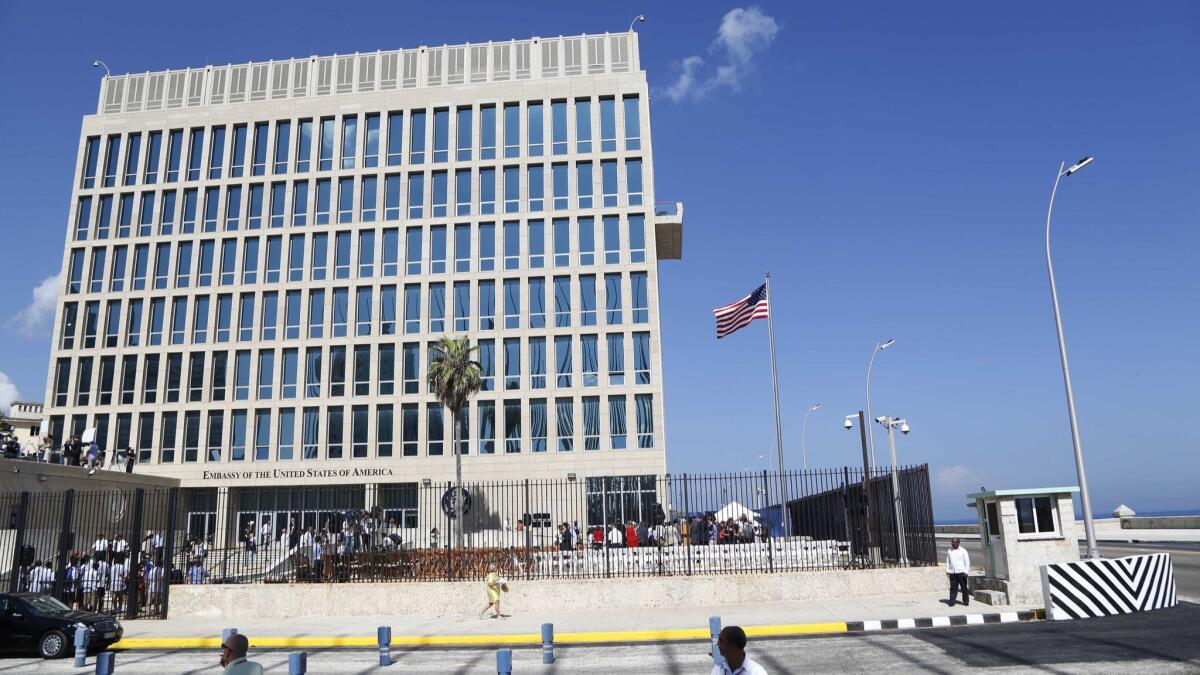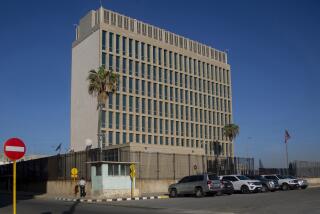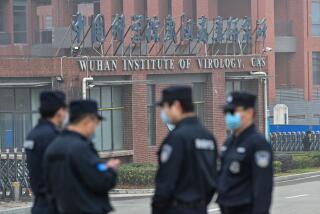Column: Is junk science adding to the mystery of the Havana embassy attacks?

- Share via
A paper out of the University of Pennsylvania earlier this year seemed to provide the most solid validation yet of the mysterious “sonic attacks” on American diplomats in Havana.
Prepared by 10 specialists at Penn’s medical school, the report cited clinical tests in accepting that at least 21 diplomats or family members had experienced such symptoms as dizziness, hearing loss, sleeplessness and cognitive impairment between November 2016 and April 2017.
“These individuals appeared to have sustained injury to widespread brain networks,” the Penn researchers reported in the journal of the American Medical Assn., despite the individuals not having suffered physical trauma such as a blow to the head. Instead, they reported hearing strange noises at night or other auditory sensations.
This condition has been branded a mystery. The mystery is how such data could have passed the scrutiny of the reviewers in a highly respected outlet like JAMA.
— Sergio Della Sala, neuroscientist
After remaining quiescent for months, the Cuban mystery surged back into the news Friday, when U.S. officials said they had evacuated two more embassy workers from Havana for testing at Penn. Ten diplomatic staffers from a U.S. consulate in China are also being tested; the State Department last week advised Americans in China to be wary of “any unusual, unexplained physical symptoms or events” related to auditory phenomena.
Any possibility that the Penn study would produce a foundation for a solution to the mystery has ebbed, however. That’s because it has brought skeptics out of the woodwork. Among them are neuroscientists Sergio Della Sala of the University of Edinburgh and Roberto Cubelli of the University of Trento, Italy, who termed the Penn paper “clinically inappropriate and methodologically improper.” Their critique appeared in the June issue of Cortex, a journal of cognitive science edited by Della Sala.
The standards for neurological impairment applied by the Penn scientists, Della Sala told me by email, were so lenient that “anybody tested — you, me, the Penn scientists, the JAMA editors, the US Embassy personnel” would be designated as impaired.
The cases have become a compelling mystery, because the symptoms are so scary and doctors and investigators haven’t been able to identify a cause. Twenty-four embassy employees and family members initially were evacuated from Havana, as were eight Canadians who reported similar though not identical symptoms. The diplomatic workforce at the Havana embassy has been permanently reduced. The U.S. expelled 15 Cuban diplomats to protest what the State Department asserted was Cuba’s failure to protect American diplomats.
Neurological researchers and law enforcement investigators have been flummoxed by the Havana cases. Proposed causes have ranged from an otherwise unknown sonic weapon directing sound bursts at the victims’ homes and hotel rooms, to psychogenic phenomena, such as stress or mass hysteria. Scientists accept that the victims’ symptoms are real: “Symptoms are real even if they are psychological in nature,” Della Sala says. “Hence, they need to be taken seriously and the people affected need to be respected.”
Yet the reported symptoms and the events that precipitated them are more varied than would appear at first glance, raising the possibility that a cause hasn’t been found because there is no external cause. Most of the reported symptoms are those that might pass without comment if there weren’t a predisposition to attribute them to some nefarious origin: headaches, dizzy spells, insomnia, blurred vision. It’s well understood that such reports can feed on themselves, especially within a small communal group under stress and living and working in shared isolation — say in an embassy in a country with a long history of mutual hostility with the United States, like Cuba.
A complicating factor is that American politicians haven’t been above exploiting the illness reports for partisan purposes. The reports first appear to have emerged in late November 2016, after the election of President Trump, who had made no secret of his distaste for his predecessor’s liberalizing of relations with Cuba. Overheated comments later came from his former Secretary of State, Rex Tillerson, and Sen. Marco Rubio, R-Fla., a critic of the Obama rapprochement. Both seemed to take it as gospel that the attacks were real or that the Cuban regime was complicit, or both. If Trump needed a pretext to draw down the staffing of the Havana embassy, suspicions that U.S. diplomats were under attack would serve ideally.
What should we make of the Penn study, then? Some of its limitations were acknowledged by the authors: of the 21 subjects, only six completed the entire battery of cognition and neurological tests in Penn’s array; the testing took place as long as 11 months after the supposed exposures, and no baseline data were available for the subjects to indicate if they had pre-existing conditions. There’s no known link to the sorts of sounds the subjects say they heard, and the symptoms they reported. The symptoms were generally subjective and self-described and the researchers weren’t “blinded” — that is, they knew what they were looking for.
Moreover, although the experiences can be lumped together as auditory, there’s a large variation in the reports. Some subjects said they heard “intensely loud” sounds, some described them as high-pitched, others as low-pitched, some as 10 seconds of noise, others as 30 minutes. They were described variously as “buzzing,” “grinding metal,” “piercing squeals” and “humming.” (The study’s corresponding author, Douglas H. Smith, hasn’t responded to my request for comment.)
Some of the data compiled by Penn are confidential, which makes it difficult for outside researchers to evaluate the paper. We know that the average age of the subjects was 43, but not whether any who reported hearing loss were at ages when people normally experience hearing loss.
Della Sala observes that the researchers labeled impairment as any test result that fell below the 40th percentile of normal response. “This means that any 4 out of 10 normal people would be classed pathological,” he says. “A threshold of 40% is unheard of in clinical practice or research.” A more appropriate threshold would be the fifth percentile, he says, meaning that only the lowest 5% of subject scores would be classed as problematic.
The real issue with the Penn paper may not be the fault of the researchers, but of those who reported on it, especially in the lay press. That’s the view of medical sociologist Robert Bartholomew, who believes the Havana cases are evidence of a “mass psychogenic illness” — that is, of psychological origin — and that the events have been exaggerated by journalists who are “not experts on acoustical weapons… or mass psychogenic illness, and are pressed for time.”
Bartholomew points out that JAMA itself raised issues with the Penn paper. One was an editorial co-written by Christopher Muth, JAMA’s associate editor, who urged “caution in interpreting the findings” in part because “many of the symptoms and signs reported occur in the general population and in individuals with other neurological illnesses.” But as Bartholomew noted, “I’m seeing headlines from media outlets trumpeting the study with little or no mention of the significant caveats that appeared in the same journal.”
Still, to Della Sala, who may be the most outspoken skeptic of the paper, its authors and the JAMA editors deserve a large measure of blame. “This condition has been branded a mystery,” he told me. “The mystery is how such data could have passed the scrutiny of the reviewers in a highly respected outlet like JAMA.”
Keep up to date with Michael Hiltzik. Follow @hiltzikm on Twitter, see his Facebook page, or email michael.hiltzik@latimes.com.
Return to Michael Hiltzik’s blog.







